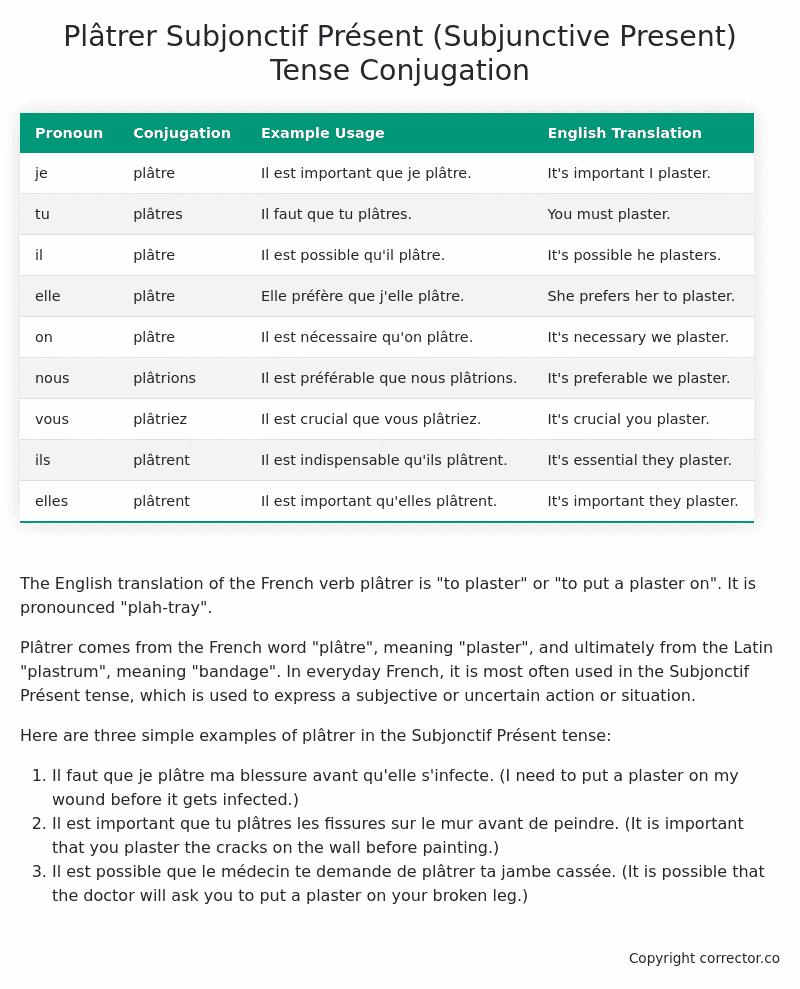Subjonctif Présent (Subjunctive Present) Tense Conjugation of the French Verb plâtrer
Introduction to the verb plâtrer
The English translation of the French verb plâtrer is “to plaster” or “to put a plaster on”. It is pronounced “plah-tray”.
Plâtrer comes from the French word “plâtre”, meaning “plaster”, and ultimately from the Latin “plastrum”, meaning “bandage”. In everyday French, it is most often used in the Subjonctif Présent tense, which is used to express a subjective or uncertain action or situation.
Here are three simple examples of plâtrer in the Subjonctif Présent tense:
- Il faut que je plâtre ma blessure avant qu’elle s’infecte. (I need to put a plaster on my wound before it gets infected.)
- Il est important que tu plâtres les fissures sur le mur avant de peindre. (It is important that you plaster the cracks on the wall before painting.)
- Il est possible que le médecin te demande de plâtrer ta jambe cassée. (It is possible that the doctor will ask you to put a plaster on your broken leg.)
Table of the Subjonctif Présent (Subjunctive Present) Tense Conjugation of plâtrer
| Pronoun | Conjugation | Example Usage | English Translation |
|---|---|---|---|
| je | plâtre | Il est important que je plâtre. | It’s important I plaster. |
| tu | plâtres | Il faut que tu plâtres. | You must plaster. |
| il | plâtre | Il est possible qu’il plâtre. | It’s possible he plasters. |
| elle | plâtre | Elle préfère que j’elle plâtre. | She prefers her to plaster. |
| on | plâtre | Il est nécessaire qu’on plâtre. | It’s necessary we plaster. |
| nous | plâtrions | Il est préférable que nous plâtrions. | It’s preferable we plaster. |
| vous | plâtriez | Il est crucial que vous plâtriez. | It’s crucial you plaster. |
| ils | plâtrent | Il est indispensable qu’ils plâtrent. | It’s essential they plaster. |
| elles | plâtrent | Il est important qu’elles plâtrent. | It’s important they plaster. |
Other Conjugations for Plâtrer.
Le Present (Present Tense) Conjugation of the French Verb plâtrer
Imparfait (Imperfect) Tense Conjugation of the French Verb plâtrer
Passé Simple (Simple Past) Tense Conjugation of the French Verb plâtrer
Passé Composé (Present Perfect) Tense Conjugation of the French Verb plâtrer
Futur Simple (Simple Future) Tense Conjugation of the French Verb plâtrer
Futur Proche (Near Future) Tense Conjugation of the French Verb plâtrer
Plus-que-parfait (Pluperfect) Tense Conjugation of the French Verb plâtrer
Passé Antérieur (Past Anterior) Tense Conjugation of the French Verb plâtrer
Futur Antérieur (Future Anterior) Tense Conjugation of the French Verb plâtrer
Subjonctif Présent (Subjunctive Present) Tense Conjugation of the French Verb plâtrer (this article)
Subjonctif Passé (Subjunctive Past) Tense Conjugation of the French Verb plâtrer
Subjonctif Imparfait (Subjunctive Imperfect) Tense Conjugation of the French Verb plâtrer
Subjonctif Plus-que-parfait (Subjunctive Pluperfect) Tense Conjugation of the French Verb plâtrer
Conditionnel Présent (Conditional Present) Tense Conjugation of the French Verb plâtrer
Conditionnel Passé (Conditional Past) Tense Conjugation of the French Verb plâtrer
L’impératif Présent (Imperative Present) Tense Conjugation of the French Verb plâtrer
L’infinitif Présent (Infinitive Present) Tense Conjugation of the French Verb plâtrer
Struggling with French verbs or the language in general? Why not use our free French Grammar Checker – no registration required!
Get a FREE Download Study Sheet of this Conjugation 🔥
Simply right click the image below, click “save image” and get your free reference for the plâtrer Subjonctif Présent tense conjugation!

Plâtrer – About the French Subjonctif Présent (Subjunctive Present) Tense
Formation of the Subjonctif Présent
Common Everyday Usage Patterns
Interactions with Other Tenses
Summary
I hope you enjoyed this article on the verb plâtrer. Still in a learning mood? Check out another TOTALLY random French verb conjugation!


